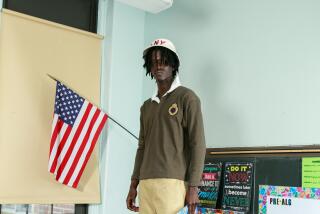Pasadena on high road of car creation
Stand on any street corner in Brentwood and watch the coolness, the hotness, roll by: Ferrari Enzo, Lamborghini Gallardo, BMW M6, Cadillac XLR, Porsche 911. These strange visitors from the planet Horsepower are the epitome of auto-exoticism. And yet each of them had their start up on a hill in little-old-lady Pasadena.
There, in the discernibly not cutting-edge neighborhood of Linda Vista, is the main campus of Art Center College of Design, a small (1,500 students), expensive ($26,000 tuition annually) and exclusive art school whose transportation program graduates rule the four-wheeled world.
Some are the automotive equivalent of rock star architects: Former department Chairman Ken Okuyama designed the notorious Ferrari Enzo, one of which came to an exciting conclusion on Pacific Coast Highway a few months ago. Art Center grad J Mays runs Ford’s worldwide design efforts and is responsible for such retro-futurism as the New Beetle (in a previous role with Volkswagen) and the Ford GT. Fellow graduate Frank Stephenson designed the immortal BMW-built Mini Cooper and later led the design team for the immoral Ferrari F430.
When you try to list the top auto designers in the world, says Ford designer Freeman Thomas, “it’s probably easier to say who isn’t from Art Center than who is.”
Thomas, himself an Art Center grad, could be forgiven for alumni pride; few would dispute that Art Center graduates dominate the field. This is partly because of seniority. The transportation program is the oldest of its kind, starting as part of the school’s industrial design program in 1932.
“Graduates of Art Center have spread all over the world,” says Peter Horbury, a Ford designer who studied at the Royal College of Art in London. “When I started back in the ‘70s,” he says, “we were astonished at the quality of work, the artistry of the people from Art Center. It’s had a huge effect ever since.”
Art Center’s transportation program, and the profession of auto design generally, emerged from the hothouse of Southern California car culture. Industry pioneer Harley J. Earl, who founded General Motors’ Art and Color Section (later renamed the Styling Section) in Detroit in 1927, was the son of a Hollywood custom coach builder. It was Earl who established the still-vital practice of designing cars using clay models.
Earl’s success at GM induced other carmakers to create their own styling studios, and in the postwar economic boom, trained car designers became highly sought-after technocrats. It was in the 1950s that Art Center’s transportation program really took off.
“Art Center was very much a trade school,” says Del Coates, a professor emeritus of industrial design at San Jose State who attended Art Center from 1954 to 1956 (at the time the campus was on 3rd Street in Hancock Park). “It was very professional. The faculty stressed that you’re here to learn how to do a job, and when you come out of here, you’re going to be pros.”
Coates, who went on to lead the rival Center for Creative Studies (now the College of Creative Studies) in Detroit, remembers his time at Art Center, sort of. “I don’t remember sleeping. It was round-the-clock work, and you had to really keep up or you would fall behind and get kicked out.”
In the 1980s, Art Center was the first art school to install computers for designers, and the school was an early testing ground for CATIA rendering software, now an industry standard.
You might think that computers would have lightened the students’ workload -- after all, when he was there in the 1950s, Coates says, “the felt-tip pen hadn’t been invented yet.” Yet, ironically, the efficiencies of digital rendering have made the program even more exhausting.
“One of the reasons our students have twice the workload than they had 10 to 15 years ago,” says Associate Chairman Geoff Wardle, “is that they have to learn all the software as well as how to be great designers.”
With the power of computerized design has come greater responsibility. In the heyday of Earl’s styling department at GM, car designers were fundamentally cosmeticians, responsible for pretty surfaces cast like a silk cloth over the automobile’s mechanical parts -- “gift wrappers,” Wardle says.
These days, designers are at the center of every car project from the beginning, synthesizing disciplines that include mechanical and human-factors engineering, materials science, aerodynamics, safety, even marketing. Where once designers and engineers took turns undercutting each other in the process, now they can work together, since everyone is working with the same database.
“Designers have always wanted to be at the head of the table,” Wardle says. “Well, now they are, and it’s a huge responsibility.”
Meanwhile, the automobile itself has become a moving target. At a time when global warming, $3-per-gallon gas and war in the Middle East has turned America’s dream machines into something of a nightmare, the transportation program -- led by Wardle and Chairman Stewart Reed -- is responding with an increased emphasis on sustainability, social responsibility and what might be called big-M mobility, a notion of transportation that breaks the gas-asphalt paradigm that has ruled automobiles for more than a century.
If you walk through the halls of Art Center, you see strange, beautifully rendered proposals of futuristic taxi modules, open-wheeled condominiums, hydrogen-powered skateboards. The automobile is being redefined -- and not a minute too soon.
“Turn up at Art Center with a new design for a cup and saucer,” Horbury says, “you’re not going to get people interested. If you turn up with a new idea about drinking tea, then they’ll be interested. Art Center is not just a school of design but a school of invention.”
But Pasadena?
“I think that’s part of the allure of Art Center,” Mays says. “There’s something very Southern California and very upscale about driving up that hill among all those rich homes in Pasadena and feeling as if you’re part of something quite important.”
More to Read
Sign up for Essential California
The most important California stories and recommendations in your inbox every morning.
You may occasionally receive promotional content from the Los Angeles Times.










